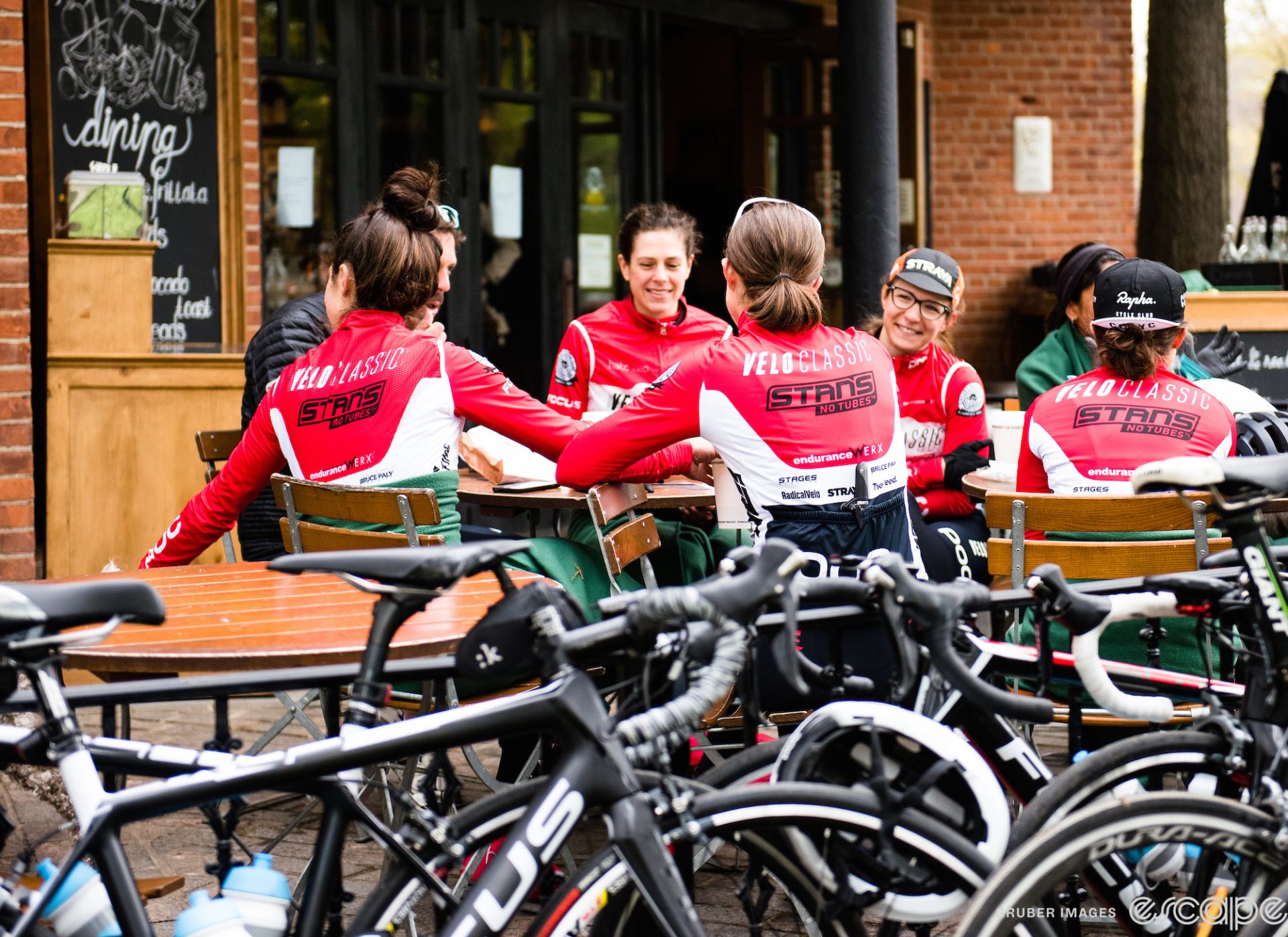It’s not often a new feature announcement from a niche app gets a story in the New York Times, but that’s exactly what happened last week when Strava launched its new direct-messaging feature.
The Grey Lady’s take on it – with a sub-headline that read “users are split between titillation (a new place to flirt!) and trepidation (a new place to flirt) …” – matched up pretty well with the reaction elsewhere.
“You come off that long run and you're all sweaty, and you're just going to fire off that risky DM,” said one user to the Times. “I've had flirty interactions in my own Strava comments. I can’t imagine what the direct messaging is going to look like," said another. Sample headlines from other media outlets included “Ride into my DMs,” “Fitness app Strava launches new feature that can help you find a date,” and a counterpoint: “No, Strava is not the new dating app.”
But underneath all the witty repartee lies two questions: what does it mean for users and what does it mean for Strava, which has had a bumpy ride the last year or so? In both possible frames, Strava and its users have been here before, which may provide some clues for what comes next.
Tech tools for good or ill
The “trepidation” aspect of DMs is front and center for users, in particular women, because any app can be a dating app if you’re bold – or creepy – enough.
Even benign tech products have a vulnerability to abuse, after all, and Strava is not immune. In January 2018, its popular Heatmap function, which uses anonymized data to show the popularity of different riding and running routes, became a major national security story after a researcher discovered it could be used to track troop locations, movements, and activity – what’s known as “pattern of life” – on even clandestine bases. And criminals have been accused of using the service to burglarize garages and even stalk victims – most recently in the Moriah Wilson murder case, where prosecutors said Kaitlin Armstrong tracked Wilson’s movements on the app.
“There are a few times I would’ve found it useful, but the downside of the creepy DMs that will inevitably result make it not worth it,” said one Escape Collective member on Discord in response to my question about the new feature. And while Strava said users have asked for DMs, others questioned whether it should be a top priority. “It was very far down on my list of improvements Strava should make,” said another EC member and early Strava adopter. “It may be somewhat useful, but a dozen other services already did that.” Forcing riders, especially women, to turn it off to avoid being hassled “defeats the utility of the feature.”
But others said they would find it useful to message other users directly in the app. “My instinctive response was ‘oh no,’ but I can see how it would be useful sometimes for coordinating rides or connecting with people afterward,” said one female EC member, who added that siloing potentially flirty communication inside Strava was actually preferable in some ways. “I’d much rather give some random guy I just met my Strava profile, not my phone number, if we might want to ride together again.”

Strava’s process for rollout is also cause for cautious optimism. The service is only available for now through the app (which makes sense since almost all DM conversation now happens on mobile). But Strava simplified the receive-message settings to just three options. “At most, only people you follow can send you a message, and you can limit it beyond that to only people who follow you back, or no one,” said a Strava spokesperson in an e-mailed response to questions about security and unwanted messages.
Refreshingly, Strava also didn’t default users to the most open option – a common tactic by social media platforms – but instead tailored it somewhat to a user’s current privacy settings. It’s also not hiding the feature in a bland “terms of use” update; the first time users open the app after the messaging rollout, they’re greeted with a notification of the new feature and the opportunity to change settings. There’s also a tool to block users, as well as filter chat invitations.
All that is designed to prevent a PR disaster like the natsec issue around Heatmap. Will it work? It’s too early to say.
What's old is new again
For Strava itself, which has been in an almost year-long period of transition and upheaval, the appearance of a clearly social-media-like feature – at a time when social media itself is broadly under strain – suggests that the business is trying to make itself a more integral part of users lives than merely a place to log and share workout info.
That became more clear this week when the company announced its 10-month search for a new CEO was ending with the hire of Michael Martin, a former YouTube executive. His hire may mark the end of a difficult year that saw Strava hit with layoffs, followed by a faceplant with an opaque new pricing strategy, followed by co-founder Michael Horvath resigning from his second stint as the company’s CEO. Martin will certainly make some changes, but the board of directors wouldn’t have hired him if he wasn’t at least philosophically on board with its goals and strategy.

But this is not Strava’s first dalliance with a social-forward business strategy. Its recent moves – social-style features like DMs and posts of something other than an activity, hiring a CEO with past social media and tech experience – recalls Strava’s plans of just five years ago.
The CEO then: James Quarles, a former Facebook and Instagram executive. The strategy: become “the home of your active life,” as Quarles told me for a feature I wrote for Outside in June 2019. The tools: expanding the types of activities Strava supported – often through integrations with brand partners – and adding different ways of posting about them and interacting with other users.
One of its new features was called Athlete Posts, where instead of an activity file, you could post other content like an activity route, photos, or a gear question to interact with other users. It’s still around, according to Strava’s Support page, but activity file posts are far more common. Still, a month prior to the DMs rollout, Strava announced a new, unnamed feature that sounds a little like a repackaged Athlete Posts, and a new brand integration with Nike.

In my Outside story, Horvath and other sources warned against assuming that Quarles’ background meant the company wanted a social-media blueprint, pointing instead to a more universal business strategy. “For a very long time, the focus has been on growth,” said Greg Gretsch, who was Strava’s earliest outside investor. Quarles, he added, “brought a new urgency to that.”
Not for long. Quarles’ tenure as CEO lasted just over two years; he was fired in November 2019, and Horvath resumed the role amid layoffs. But under Quarles and after, Strava has certainly grown. At the time my story published (June 2019), Strava had a little more than 42 million user accounts. It now has more than double that, and the company claims most of the increase happened in the last two years. Strava’s valuation, based on its latest funding round, is "north of $1.5 billion" according to a Wall Street Journal story about the funding round: four times what it was for its previous funding round in 2018.
But there are some caveats: many of those 100 million claimed accounts are inactive, zombie profiles, which haven’t posted anything in months or years. And Strava’s business has always been what’s called a “freemium” subscription model: anyone can sign up and use basic services for free, which are monetized mostly by members who pay a premium to get more features. But in analyses done in 2015 (by Mark Slavonia) and 2019 (by me), somewhere between 1-5% of users are Premium members. Even accounting for all the zombie profiles, there are a lot of free users posting activities, interacting with other Strava members, and generally Hoovering up server space and development costs without paying a dime. Strava's challenge has always been how to convince more users to go Premium, but it has historically been reluctant to force that. Messaging, at least for now, is open to all users.
Financially, Strava wasn’t profitable in 2019 and may not be now, even at more than 2x the user base and 4x the valuation. Speaking of valuations, even that impressive unicorn figure doesn’t necessarily say much about what the company is worth, or its cash position. The valuation is essentially Strava's own estimate. The Series F funding round was mostly from existing lead investors like Sequoia Capital and TCV. And while that infusion of funds was significant – $110 million, far more than all its previous funding combined – it also took place in November 2020, and neither Pitchbook, Crunchbase, nor any other outlet that tracks venture capital has noted any major investment since.
What is Strava's place in the social pack?
Ultimately, it’s not clear that even a much larger Strava is in a materially different place today as a business than it was half a decade ago, even as it pursues what appears to be a similar approach. But one thing has changed in that time: social media itself.
Five years ago, then-new TikTok had 54 million users worldwide, while Elon Musk was just getting himself in hot water with the Securities and Exchange Commission over a pair of tweets where he claimed he’d secured funding to take Tesla private (he very much had not). Today, TikTok has 1.8 billion users and is the target of (likely unsuccessful) attempts to ban it in the United States, while Twitter/X craters under Musk’s ownership. Instagram and Facebook are overrun with ads and influencers. Other platforms, like Snapchat, are experiencing traffic and user declines or have largely failed to grow after initial interest (a prominent exception is Threads, but it still lacks the broad cultural currency that Twitter had even a year ago). The zenith of massive social platforms likely happened somewhere along the way.

In contrast to Musk’s vision of X as an everything network like China’s WeChat, the future may be a constellation of dozens of smaller, more niche-oriented services, some of which have existed for years but are finding new audiences in smaller, affinity-based communities: stuff like Letterboxd for film fans, or Escape’s own Discord. Former Twitter CEO Jack Dorsey is pushing decentralized networks, and users are decentralizing their online lives. As Ethan Zuckerman, a public policy professor at the University of Massachussetts, told the New York Times for an April story on the evolution of social media, “The future is that you’re a member of dozens of different communities, because as human beings, that’s how we are.”
In that world, Strava’s push to become more social – to finally make good on Quarles’ promise to be the online home of your active life – might be a savvy strategy.
But it’s a little tough to say, partly because no one really knows how social media will evolve. More to the point, Strava won’t tip its hand on its plans. The company declined my interview request for this story, agreeing instead to answer questions via e-mail. But the spokesperson’s written answers gave little hint about how the company sees itself evolving as a social media service. “There is space in this ecosystem for even more connection to foster that love of movement across our community and Messaging is a feature that is supporting that endeavor,” read one carefully constructed example of brand-messaging discipline. When asked whether DMs might be a sign of Strava’s future direction on features and strategy, the spokesperson said only that the feature “reflects our team’s dedicated effort to enhance the athlete experience” on Strava and that more features would be coming in 2024.
Strava’s success or failure with new social-centric features like DMs may rest on two important questions, only one of which is in its control. Much like many pieces of online technology, Strava’s DM feature almost certainly has a vulnerability of some kind that may at some point be exploited for malevolent purpose in ways its designers never anticipated. If zero day comes, Strava’s response to it will matter as much or more than all of the careful front-end work it’s done so far, and quite honestly, the company has had a spotty track record in the past (its initial response to the Heatmap issue was to essentially blame users for having failed to set their profiles to private; Strava says private activity data isn't used for Heatmap).
But at least that’s all in its control. The bigger question is whether a significant chunk of its users want Strava to be a native messaging app. If they don’t, then DMs could actually backfire, effectively shrinking Strava and its power to connect users, as members restrict profile access and consciously curtail their networks. As one Escape member said on Discord, “I could see people who will be more hesitant to follow people if they know it might come with a DM.”
That Strava – a universe of tiny networks increasingly walled off from each other, and largely a repository for training data and route information – is a perfectly fine service. What it’s not is a company worth anywhere near $1.5 billion.
Did we do a good job with this story?






